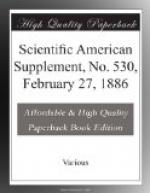[Illustration: NEW PHOTOGRAPHIC APPARATUS.]
As the objective is of short focus, every object situated beyond a distance of three yards from the apparatus is in focus. In exceptional cases, where the operator might be nearer the object to be photographed, the focusing would be done by means of the rack of the objective. The latter can also slide up and down, so that the apparatus need not be inclined when buildings or high trees are being photographed. The door, E, performs the role of a shade. When the apparatus has been fixed upon its tripod and properly directed, all the operator has to do is to close the door, P, and raise the mirror, M, by turning the button, B, and then expose the plate. The sensitized plates are introduced into the apparatus through the door, I, and are always brought automatically to the focus of the objective through the pressure of the springs, R. The shutter of the frame, B, opens through a hook, H, with in the pocket, N. After exposure, each plate is lifted by means of the extractor, K, into the pocket, whence it is taken by hand and introduced through a slit, S, behind the springs, R, and the other plates that the frame contains. All these operations are performed in the interior of the pocket, N, through the impermeable, triple fabric of which no light can enter.
An automatic marker shows the number of plates exposed. When the operations are finished, the objective is put back in the interior of the camera, the doors, P and E, are closed, and the pocket is rolled up. The apparatus is thus hermetically closed, and, containing all the accessories, forms one of the most practical of systems for the itinerant photographer.—La Nature.
* * * * *
METEORITES.
In our SUPPLEMENT No. 529 we gave an abstract of Prof. Dewars recent series of lectures on the above subject at the Royal Institution. We now present an abstract of the last and concluding lecture.
THE DHURMSALA. METEORITE.
After the conclusion of his last lecture, Prof. Dewar distributed among the younger listeners small pieces of a portion of the Dhurmsala meteorite, which had been broken up for presentation to them by Mr. J.R. Gregory, whose collection of rare minerals was recently to some extent described in these pages. The lecturer stated that Sir F. Abel had given him a large piece of a large meteorite, because he thought that the speaker’s piece ought to be bigger than theirs.
Professor Dewar also presented the listeners with a printed detailed account of the fall of the Dhurmsala meteorite, including the report of the occurrence sent to the Punjaub Government, and dated July 28, 1860. The following are the main facts:




